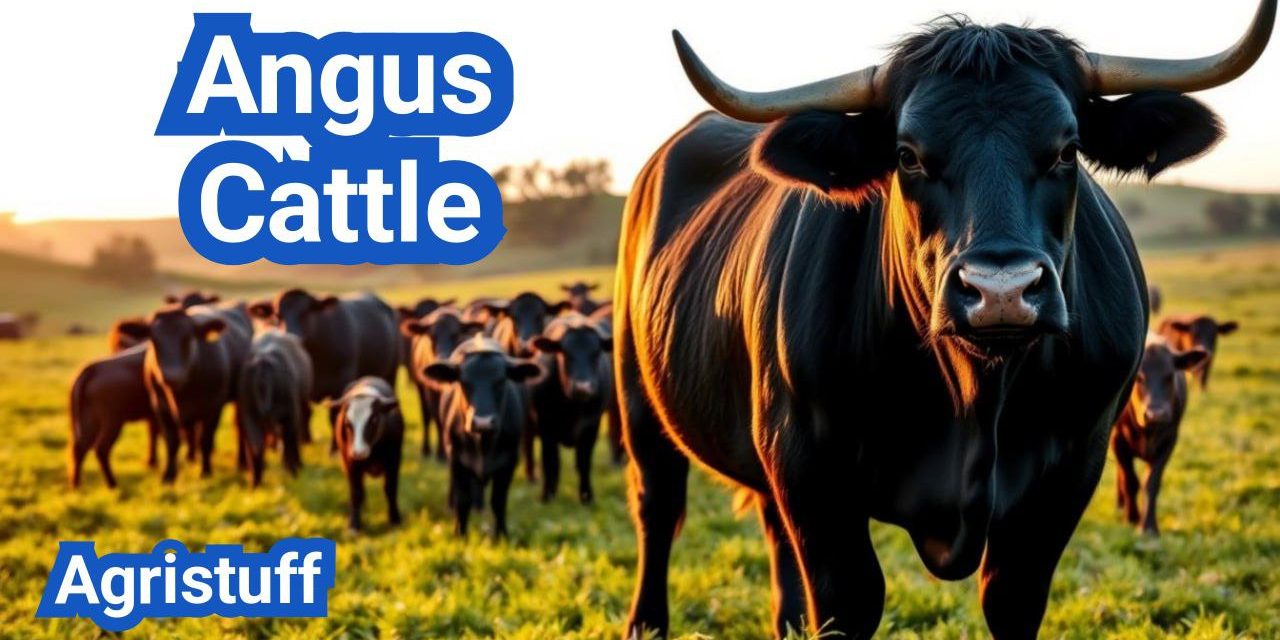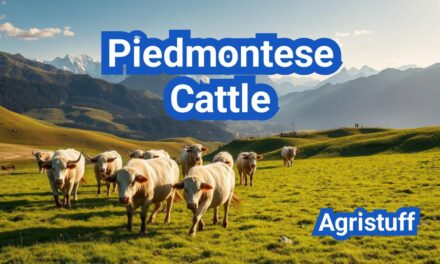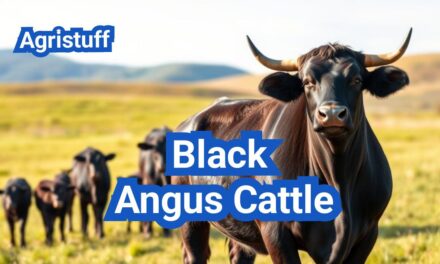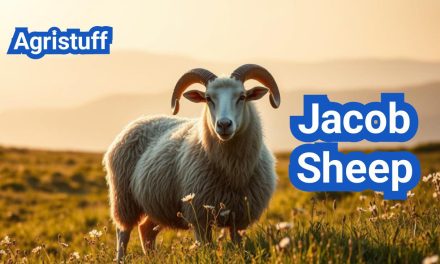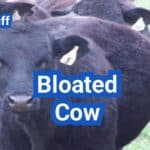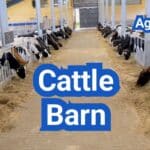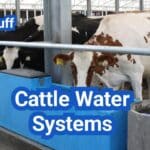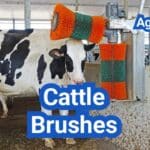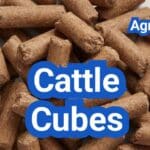The Angus cattle breed is renowned for its high-quality beef and is one of the most popular beef cattle breeds globally.
Originating in Scotland, specifically in the counties of Aberdeen, Banff, and Angus, this breed has a rich history dating back to the 19th century.
The breed is characterized by its black or red color, with black being the dominant color, and is naturally polled, making them easier to handle.
Key Takeaways
- The Angus cattle breed originated in Scotland.
- Known for its high-quality beef and marbling ability.
- Naturally polled, making them easier to handle.
- Black or red color, with black being dominant.
- One of the most popular beef cattle breeds globally.
The History and Origin of Angus Cattle
With its origins in the northeastern part of Scotland, the Angus cattle breed has become one of the most recognized cattle breeds worldwide. The breed’s history is deeply rooted in the country’s agricultural heritage, particularly in the counties of Aberdeen, Banff, and Angus.
Aberdeen Angus: The Scottish Beginning
The development of Angus cattle began in the early 19th century, driven by the need for high-quality beef production. Key figures such as Hugh Watson and William McCombie played a crucial role in establishing the breed’s characteristics. Their efforts focused on creating a robust and efficient cattle breed that could thrive in Scotland’s climate.
Early Development in Angus and Aberdeenshire Counties
The counties of Angus and Aberdeenshire were pivotal in the early development of the Angus breed. The local cattle were known for their hardiness and beef production qualities, which became the foundation for the modern Angus breed. The breeders of the time worked tirelessly to refine these traits, resulting in a cattle breed that was both resilient and productive.
Introduction to America and Global Expansion
The Angus breed was later introduced to America, where it gained popularity for its beef production qualities. The breed’s adaptability to different climates and its robust nature made it an attractive choice for cattle farmers worldwide. Today, Angus cattle can be found in many countries, contributing significantly to the global beef industry.
The history of Angus cattle is a testament to the breed’s versatility and the dedication of early breeders. From its Scottish roots to its global presence, the Angus breed continues to be a significant player in the world’s cattle industry.
Understanding Angus Cattle Breed Characteristics
Angus cattle have several key characteristics that make them a popular choice in the beef industry. Their breed characteristics are defined by their color, breed standards, and physical traits.
Black Angus vs. Red Angus Varieties
Angus cattle are primarily known for their black color, but they also come in red. The black color is dominant, but the red color is also recognized and registered. Both black and red Angus share many characteristics, including their high-quality beef and hardiness.
The main difference between black and red Angus is their coat color. While black Angus are more common, red Angus have gained popularity due to their unique appearance.
Registered Angus Standards
To be registered, Angus cattle must meet specific breed standards. These standards include their genetic purity, physical characteristics, and performance traits. The American Angus Association maintains these standards to ensure the breed’s integrity.
The Polled (Hornless) Advantage
One of the significant advantages of Angus cattle is that they are naturally polled, or hornless. This trait reduces the risk of injury to both the animals and handlers. The polled characteristic is highly heritable and is considered a dominant trait in Angus cattle.
| Characteristic | Black Angus | Red Angus |
|---|---|---|
| Coat Color | Black | Red |
| Breed Standards | Genetic purity, physical characteristics, and performance traits | |
| Polled Trait | Naturally hornless, highly heritable |
Physical Traits and Characteristics of Angus Cattle

The Angus cattle breed is renowned for its distinctive physical characteristics, which play a crucial role in its popularity among cattle breeders and beef producers. Angus cattle are characterized by their compact, muscular bodies and are generally medium-sized.
Size and Weight Specifications
Angus cattle are known for their efficient growth rate and muscular build. Bulls can weigh up to 1000 kg, while cows typically weigh around 650 kg. The size and weight of Angus cattle can vary depending on factors such as genetics, nutrition, and management practices.
Body Structure and Conformation
The body structure of Angus cattle is compact and muscular, with a deep, well-sprung ribcage and a strong, straight back. This conformation contributes to their high-quality beef production. The breed’s muscular build and efficient growth rate make it a preferred choice for many beef producers.
Distinctive Physical Features
Angus cattle are known for their black or red coat color, although black is more common. They are also characterized by their polled (hornless) feature, which simplifies handling and reduces the risk of injury. The breed’s physical traits, including their size, weight, and body structure, contribute to their overall appeal and productivity.
In summary, the physical traits and characteristics of Angus cattle, including their size, weight, and body structure, make them a popular choice for beef production. Their compact, muscular build and efficient growth rate are key advantages that contribute to their success in the industry.
Behavioral Traits and Handling Techniques
The docile nature and strong maternal instincts of Angus cattle make them an ideal breed for many cattle operations. Their temperament and behavior play a crucial role in their handling and overall farm productivity.
Typical Angus Temperament
Angus cattle are renowned for their calm and docile temperament, which makes them easier to handle compared to more aggressive breeds. This trait is particularly beneficial for farmers who are new to cattle farming or those who prefer a more manageable herd.
Maternal Instincts and Calving Ease
Angus cows are known for their strong maternal instincts, making them good mothers to their calves. They are also recognized for their ease of calving, which reduces the need for human intervention during the birthing process. This natural ability ensures healthier calves and less stress for both the cow and the farmer.
Effective Handling Methods for Angus
Handling Angus cattle effectively requires an understanding of their behavior and temperament. Gentle handling practices, such as moving slowly and calmly around them, can significantly reduce stress and improve overall handling efficiency. It’s also essential to be aware of their body language to anticipate and prevent any potential issues.
| Handling Technique | Benefit |
|---|---|
| Gentle Movement | Reduces Stress |
| Awareness of Body Language | Prevents Potential Issues |
| Calm Environment | Improves Handling Efficiency |
By understanding and leveraging the behavioral traits of Angus cattle, farmers can create a more efficient and stress-free cattle handling experience. This not only benefits the animals but also enhances the overall productivity of the farm.
How to Select Quality Angus Cattle

Selecting high-quality Angus cattle is crucial for a successful cattle operation. The quality of the cattle directly impacts the productivity and profitability of the farm.
Evaluating Physical Traits
When evaluating Angus cattle, physical traits are a critical consideration. Look for cattle with well-developed muscling, a sturdy body structure, and a robust overall conformation. Key physical characteristics include:
- Muscling: Cattle should have well-developed muscles, particularly in the hindquarters.
- Body Structure: A deep, wide chest and a well-sprung ribcage are indicators of good body structure.
- Conformation: The overall conformation should be robust, with a straight or slightly convex profile.
Assessing Genetic Background
Assessing the genetic background of Angus cattle is vital to ensure they meet breed standards. This involves reviewing pedigree information and genetic testing results. Key factors to consider include:
- Pedigree: A reputable pedigree is essential for verifying the cattle’s lineage.
- Genetic Testing: Genetic testing can provide insights into the cattle’s genetic makeup and potential for certain traits.
Important Health Indicators
Health indicators are also crucial when selecting Angus cattle. Look for cattle with a healthy appearance, including:
- Vitality: Cattle should appear vigorous and alert.
- Coat Condition: A healthy coat is a good indicator of overall health.
- Absence of Disease: Ensure the cattle are free from visible signs of disease or injury.
By carefully evaluating physical traits, assessing genetic background, and considering health indicators, you can select high-quality Angus cattle that will enhance your cattle operation.
Setting Up Your Angus Cattle Operation
Setting up an Angus cattle operation is a multifaceted process that demands careful consideration of various factors, including land, equipment, and financial investment. A well-planned operation is crucial for the success and profitability of the cattle farm. It involves several key components that need to be addressed.
Land and Space Requirements
The first step in establishing an Angus cattle operation is to ensure adequate land and space. The amount of land required depends on several factors, including the number of cattle, grazing practices, and local regulations. Generally, a minimum of 2-5 acres per cow is recommended to provide sufficient grazing and to maintain soil quality.
Adequate land not only supports the cattle but also contributes to the overall sustainability of the operation. It allows for crop rotation, manure management, and conservation practices. Ensuring that the land is well-managed is crucial for maintaining its productivity and ecological balance.
Essential Equipment and Facilities
Investing in the right equipment and facilities is vital for the efficient management of an Angus cattle operation. Essential equipment includes tractors, fencing materials, feeding and watering systems, and handling facilities. The quality and condition of this equipment directly impact the daily operations and the well-being of the cattle.
Facilities such as barns, sheds, and fencing are necessary to protect the cattle from harsh weather conditions and predators. Well-designed handling facilities are also crucial for safe and efficient cattle management, including vaccinations, breeding, and cattle movement.
Initial Investment Considerations
The initial investment for setting up an Angus cattle operation can be substantial. It includes the cost of land acquisition or leasing, purchasing cattle, equipment, and facilities, as well as initial operational costs such as feed, veterinary care, and labor. A detailed financial plan is essential to manage these costs effectively.
Understanding the initial investment and ongoing expenses helps in planning for the financial sustainability of the operation. It’s also important to explore financing options, grants, or subsidies that may be available for agricultural projects.
| Component | Estimated Cost | Considerations |
|---|---|---|
| Land Acquisition/Leasing | $5,000 – $20,000 per acre | Location, soil quality, zoning regulations |
| Cattle Purchase | $1,000 – $3,000 per head | Quality, breed, age, health status |
| Equipment and Facilities | $50,000 – $200,000 | Tractors, fencing, feeding systems, handling facilities |
| Initial Operational Costs | $10,000 – $50,000 | Feed, veterinary care, labor, marketing |
Implementing Effective Breeding Programs

To maximize the potential of Angus cattle, farmers must implement well-structured breeding programs. These programs are designed to enhance the quality, productivity, and profitability of Angus cattle operations.
Effective breeding programs involve careful consideration of breeding strategies, including purebred breeding and crossbreeding. Purebred breeding focuses on maintaining the genetic integrity of the Angus breed, while crossbreeding aims to leverage hybrid vigor to improve cattle performance.
Purebred Breeding Strategies
Purebred Angus breeding involves selecting animals that embody the breed’s characteristic traits, such as marbling ability and growth rate. This approach requires meticulous record-keeping and genetic analysis to ensure the continuation of desirable traits.
The benefits of purebred breeding include:
- Consistency in cattle quality
- Predictable performance characteristics
- Maintenance of breed standards
Crossbreeding with Angus for Hybrid Vigor
Crossbreeding Angus cattle with other breeds can result in hybrid vigor, where the offspring exhibit superior traits compared to either parent breed. This strategy is particularly useful for improving growth rates, fertility, and disease resistance.
| Crossbreeding Combination | Advantages |
|---|---|
| Angus x Hereford | Improved hardiness and fertility |
| Angus x Simmental | Enhanced growth rate and muscling |
| Angus x Wagyu | Increased marbling and premium beef quality |
Genetic Selection for Desired Traits
Genetic selection is a critical component of effective breeding programs. By identifying and selecting for desired traits, breeders can accelerate genetic progress and improve the overall quality of their Angus cattle.
Key traits for selection include:
- Marbling ability
- Growth rate
- Reproductive efficiency
By combining purebred breeding strategies, crossbreeding for hybrid vigor, and genetic selection for desired traits, Angus cattle breeders can develop effective breeding programs that enhance the productivity and profitability of their operations.
Daily Management of Angus Cattle

To ensure the optimal health and productivity of Angus cattle, farmers must implement a comprehensive daily management plan. This involves understanding and addressing the specific needs of the cattle at different stages of their life cycle.
Nutritional Requirements Throughout Life Stages
Angus cattle have varying nutritional requirements as they grow from calves to mature animals. Calves require high-quality milk and starter feeds, while growing cattle need a diet rich in proteins and energy. Mature cattle, on the other hand, require maintenance-level nutrition, with adjustments based on their production stage, such as lactation.
| Life Stage | Nutritional Requirements |
|---|---|
| Calves | High-quality milk, starter feeds |
| Growing Cattle | High-protein, high-energy diets |
| Mature Cattle | Maintenance-level nutrition, adjusted for production stage |
Pasture Management Practices
Effective pasture management is crucial for maintaining the quality and quantity of feed available to Angus cattle. Practices include rotational grazing to prevent overgrazing, maintaining soil fertility through appropriate fertilization, and monitoring pasture health.
Health Monitoring and Disease Prevention
Regular health monitoring is essential for early detection of diseases and parasites. This includes checking for signs of illness, monitoring parasite loads, and implementing vaccination programs as necessary. Preventive measures such as parasite control programs and biosecurity protocols are also vital.
By focusing on these key areas, farmers can ensure the daily management of their Angus cattle is effective, promoting overall health, productivity, and profitability.
Optimizing Angus Cattle Production in Different Climates

The adaptability of Angus cattle to various environments is a significant advantage, yet climate-specific strategies are crucial for optimal production. Angus cattle are known for their hardiness and ability to thrive in different conditions, but farmers must still consider the impact of climate on their operations.
Adaptability to Various Environments
Angus cattle have been successfully raised in diverse climates, from the temperate regions of the United States to the more extreme conditions found in Australia and South America. Their adaptability is largely due to their robust genetic makeup and the breed’s history of selection for hardiness.
Special Considerations for Extreme Weather
While Angus cattle are generally resilient, extreme weather conditions such as intense heat or cold can pose significant challenges. Heat stress, for example, can lead to reduced fertility and growth rates. To mitigate these effects, farmers can implement strategies such as providing shade, ensuring adequate ventilation, and adjusting feeding schedules.
Regional Management Adjustments
Regional management adjustments are essential for optimizing Angus cattle production. This includes selecting appropriate breeds or strains suited to the local climate, managing pasture and feed resources effectively, and implementing health programs tailored to regional disease risks.
| Climate Condition | Management Strategy | Benefits |
|---|---|---|
| High Temperatures | Provide shade, adjust feeding schedules | Reduced heat stress, improved fertility |
| Cold Temperatures | Ensure adequate nutrition, provide shelter | Improved health, reduced mortality |
| High Rainfall | Manage pasture to prevent overgrazing | Maintained pasture quality, reduced erosion |
By understanding the specific challenges posed by different climates and implementing targeted management strategies, farmers can optimize Angus cattle production and maintain the health and productivity of their herds.
Angus Cattle vs. Other Popular Beef Breeds

In the realm of beef cattle, Angus, Hereford, Charolais, and Simmental are prominent breeds, each with unique characteristics that cater to different production needs. Understanding the differences between these breeds is crucial for producers to make informed decisions about their operations.
Detailed Comparison with Hereford Cattle
Hereford cattle are known for their hardiness and ease of handling, making them a popular choice for many producers. Compared to Angus, Herefords are often praised for their:
- Greater resistance to certain diseases
- Ease of calving due to their maternal instincts
- Hardiness in various environmental conditions
However, Angus cattle are renowned for their marbling ability, which results in high-quality beef. The choice between Angus and Hereford often comes down to the producer’s specific goals and the market they are targeting.
Advantages Over Charolais and Simmental
Charolais and Simmental are breeds known for their rapid growth rates and muscular development. While they offer advantages in terms of size and growth, Angus cattle have:
- Superior marbling, which enhances beef quality
- A more established brand in the premium beef market
- Proven reproductive efficiency
Angus cattle are often preferred in crossbreeding programs to impart their desirable traits to offspring.
When to Consider Alternative or Crossbred Options
While Angus cattle are highly regarded, there are scenarios where alternative or crossbred cattle might be more suitable:
- In harsh environments, breeds with greater hardiness (like Hereford) might be preferable.
- For producers looking to increase size and muscling, Charolais or Simmental might be better choices or used in crossbreeding programs.
- Crossbred cattle can offer hybrid vigor, combining the best traits of different breeds.
In conclusion, while Angus cattle are a popular choice for beef production, the decision to use them should be based on a thorough comparison with other breeds like Hereford, Charolais, and Simmental, considering factors such as production goals, market demands, and environmental conditions.
Marketing Your Angus Beef Products

To successfully market Angus beef, producers must navigate the Certified Angus Beef requirements and explore direct-to-consumer strategies. Understanding the nuances of the Certified Angus Beef program is crucial for any producer looking to capitalize on the premium quality of their Angus beef.
Understanding Certified Angus Beef Requirements
The Certified Angus Beef (CAB) program is a prestigious certification that ensures Angus beef meets certain quality standards. To qualify, beef must come from Angus cattle and meet specific marbling, maturity, and other criteria. Key requirements include:
- Angus breed origin
- Marbling score of Modest or higher
- Maturity level of A or B
- Medium to fine marbling texture
Producers must work closely with certified processors to ensure their beef meets these standards. The CAB label is recognized for its commitment to quality, making it a valuable marketing tool.
Direct-to-Consumer Marketing Strategies
Direct-to-consumer marketing allows Angus beef producers to connect directly with consumers, potentially increasing profit margins. Strategies include:
- Developing an online presence through websites and social media
- Participating in farmers’ markets and local events
- Creating community-supported agriculture (CSA) programs
By engaging directly with consumers, producers can build brand loyalty and educate customers about the quality and benefits of Angus beef.
Value-Added Angus Products
Creating value-added products is another effective marketing strategy. This can include premium beef cuts, specialty sausages, or marinated products. Value-added products not only command higher prices but also help differentiate a producer’s offerings in a competitive market.
For instance, offering grass-finished Angus beef or dry-aged Angus steaks can attract consumers looking for unique products. Producers can also consider partnering with local chefs or restaurants to create exclusive Angus beef dishes.
By understanding and leveraging Certified Angus Beef requirements, employing direct-to-consumer marketing strategies, and developing value-added products, Angus beef producers can effectively market their products and enhance their profitability.
Working with Specialized Angus Varieties

Producers are increasingly turning to specialized Angus varieties to meet the demands of diverse markets and production systems. These varieties offer unique characteristics that can enhance production efficiency, product quality, and marketability.
Raising Lowline Angus for Smaller Operations
Lowline Angus are a smaller version of the traditional Angus breed, making them ideal for smaller operations or those with limited land resources. They retain the high-quality beef characteristics of their larger counterparts but require less feed and space.
Key benefits of Lowline Angus include:
- Lower feed requirements
- Reduced land needs
- Easier handling due to smaller size
- High-quality beef production
Managing Popular Angus Crossbreeds
Angus crossbreeds are gaining popularity for their hybrid vigor and the ability to combine the best traits of different breeds. When managing Angus crossbreeds, producers should focus on selecting breeds that complement the Angus characteristics and enhance the desired production traits.
| Crossbreed | Characteristics | Advantages |
|---|---|---|
| Angus x Simmental | Combines Angus marbling with Simmental growth rate | Enhanced growth rate, improved carcass quality |
| Angus x Hereford | Blends Angus quality with Hereford hardiness | Increased hardiness, improved maternal traits |
| Angus x Charolais | Combines Angus marbling with Charolais muscling | Improved muscling, enhanced carcass yield |
Producing Premium Angus-Wagyu Beef
Angus-Wagyu beef is a premium product that combines the marbling characteristics of Wagyu cattle with the high-quality beef traits of Angus. Producing Angus-Wagyu beef requires careful breeding and management to achieve the desired level of marbling and quality.
The production of Angus-Wagyu beef involves selecting Angus and Wagyu breeds that complement each other in terms of marbling, growth rate, and carcass quality. This premium product commands a higher price in the market due to its unique characteristics and high-quality beef.
Utilizing Angus Cattle Resources and Support

Angus cattle breeders can significantly benefit from various resources and support systems available in the industry. By leveraging these resources, breeders can improve their operations, enhance their knowledge, and stay updated on best practices.
Benefits of Association Membership
Joining an Angus association can provide numerous benefits, including access to exclusive resources, educational opportunities, and networking events. Members can stay informed about the latest developments in Angus cattle breeding and management through association publications and events.
Educational Resources for Angus Breeders
Angus breeders have access to a range of educational resources, including workshops, webinars, and online courses. These resources cover topics such as breeding strategies, cattle management, and marketing techniques, helping breeders to enhance their skills and knowledge.
Participating in Shows and Networking Events
Participating in shows and networking events is an effective way for Angus breeders to showcase their cattle, connect with other breeders, and stay updated on industry trends. These events provide opportunities for breeders to learn from industry experts and share their experiences with others.
| Resource | Description | Benefits |
|---|---|---|
| Association Membership | Joining an Angus association | Access to resources, education, and networking |
| Educational Resources | Workshops, webinars, and online courses | Enhanced knowledge and skills in breeding and management |
| Shows and Networking Events | Participating in cattle shows and industry events | Opportunities for networking, learning, and showcasing cattle |
The Future of Angus Cattle in American Agriculture
The Angus cattle breed has established itself as a cornerstone of American agriculture, with its high-quality beef driving consumer demand. As the Angus cattle industry continues to evolve, its significance in the country’s beef production remains unwavering.
The adaptability and superior traits of Angus cattle make them an ideal choice for farmers and ranchers across the United States. With the industry expected to grow, driven by increasing demand for premium beef products, the future of Angus cattle in American agriculture looks bright.
As the Angus cattle industry moves forward, it is likely to be shaped by advancements in breeding programs, nutritional management, and marketing strategies. By leveraging these opportunities, producers can continue to capitalize on the breed’s strengths, ensuring the long-term sustainability of Angus cattle in American agriculture.
FAQ
What is the origin of the Angus cattle breed?
The Angus cattle breed originated in Scotland, specifically in the counties of Aberdeen, Banff, and Angus, in the early 19th century.
What are the main characteristics of Angus cattle?
Angus cattle are known for their black or red color, with black being the dominant color. They are naturally polled, meaning they do not have horns, and are characterized by their compact, muscular bodies and high-quality beef.
What is the difference between Black Angus and Red Angus?
The main difference between Black Angus and Red Angus is their coat color. Black Angus have a black coat, while Red Angus have a red coat. Both varieties are known for their high-quality beef and are registered under the same breed standards.
What are the benefits of raising Angus cattle?
Raising Angus cattle offers several benefits, including their high-quality beef, ease of handling due to their docile temperament, and strong maternal instincts. They are also known for their ease of calving, reducing the need for human intervention during the birthing process.
How do I select high-quality Angus cattle?
Selecting high-quality Angus cattle involves evaluating their physical traits, such as muscling and body structure, assessing their genetic background, and considering important health indicators.
What are the nutritional requirements of Angus cattle at different life stages?
The nutritional requirements of Angus cattle vary at different life stages. For example, calves require a diet rich in nutrients to support their growth and development, while mature cows require a balanced diet to maintain their overall health and productivity.
How can I optimize Angus cattle production in different climates?
Optimizing Angus cattle production in different climates requires an understanding of the breed’s adaptability to various environments. Special considerations are necessary for extreme weather conditions, and regional management adjustments may be required to ensure the cattle remain healthy and productive.
What is the Certified Angus Beef program, and how do I participate?
The Certified Angus Beef program is a certification program that ensures Angus beef products meet certain quality standards. To participate, producers must meet the program’s requirements, which include raising Angus cattle that meet specific breed standards and following certain production practices.
What are the benefits of joining an Angus association?
Joining an Angus association provides numerous benefits, including access to educational resources, networking opportunities, and participation in shows and events. Association membership can also provide breeders with valuable information and support to help them improve their breeding programs.
What is the future of Angus cattle in American agriculture?
The future of Angus cattle in American agriculture looks promising, with the breed continuing to play a significant role in the country’s beef production. The industry is expected to continue growing, driven by consumer demand for high-quality beef.
Conclusion of: Angus Cattle | Breed, Traits, Origin and Uses
Angus cattle are among the most well-known and widely bred beef cattle breeds in the United States and globally. Known for their superior meat quality, adaptability, and genetic consistency, Angus cattle have become the top choice for beef producers and consumers alike. This article explores the origin, physical and behavioral traits, and the various uses of the Angus cattle breed.
What Are Angus Cattle?
Angus cattle, also known as Aberdeen Angus, are a breed of beef cattle originating from Scotland. They are naturally polled (hornless) and are typically black or red in color. Angus cattle are valued for their efficient feed conversion, docile temperament, and high-quality marbled beef.
Source: Oklahoma State University – Breeds of Livestock
Origin and History of Angus Cattle
The Angus cattle breed was developed in the counties of Aberdeenshire and Angus in northeastern Scotland. They were first imported to the U.S. in the 1870s and rapidly gained popularity due to their hardiness and meat quality. Today, they are the most registered beef breed in the U.S.
Source: American Angus Association
Physical Characteristics of Angus Cattle
Angus cattle are medium-sized with a solid black or red coat, though black is more common. They are naturally polled and known for their muscular build and strong legs. Their hide is smooth, and their frame allows for easy calving and efficient growth.
Behavioral Traits of Angus Cattle
The temperament of Angus cattle is generally calm, which makes them easier to manage compared to more aggressive breeds. Their gentle nature reduces stress on the animals and handlers alike, contributing to better weight gain and meat quality.
Source: University of Florida Extension
Meat Quality and Marbling in Angus Cattle
A major advantage of Angus cattle is their beef quality. They produce finely marbled meat that is tender, juicy, and flavorful. This is why “Certified Angus Beef” has become a premium standard in the beef industry.
Common Uses of Angus Cattle
Angus cattle are raised primarily for beef production. They are also used in crossbreeding programs to enhance meat quality in other breeds. Their docile nature makes them suitable for rotational grazing and low-input farming systems.
Source: Sustainable Agriculture Research & Education (SARE)
Advantages of Raising Angus Cattle
Benefits of raising Angus cattle include:
- High beef yield with superior marbling
- Naturally hornless, reducing injuries
- Excellent fertility and calving ease
- Strong genetics and widespread availability
Source: University of Missouri Extension
Angus Cattle in the U.S. Market
In the U.S., Angus cattle dominate the beef market. Certified Angus Beef is a recognized label that assures consumers of top-quality meat. This marketing strategy has significantly increased consumer demand and farm profitability.
Source: USDA Agricultural Marketing Service
Breeding and Genetics of Angus Cattle
Breeding Angus cattle requires careful selection to maintain their desired traits. Artificial insemination (AI) and genomic testing are widely used to improve meat quality, feed efficiency, and disease resistance.
Source: National Animal Germplasm Program – USDA
Challenges in Raising Angus Cattle
Despite their popularity, Angus cattle farming comes with challenges:
- Susceptibility to heat stress
- Competition in premium beef markets
- Need for high-quality forage or grain
These can be mitigated with proper farm management and strategic breeding.
Final Thought
Angus cattle are a premier beef breed known for their superior marbling, docile temperament, and excellent growth rates. With proper management, they offer significant advantages in meat quality, profitability, and sustainability. Understanding the traits and uses of Angus cattle is essential for farmers aiming to succeed in today’s competitive beef market.

